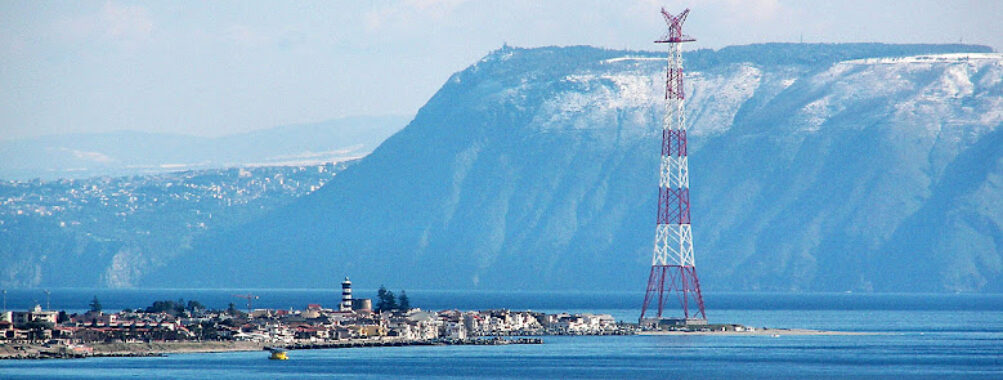
Piloni di Torre Faro
Table of Contents
Description
The Piloni di Torre Faro are one of those places in Sicily that quietly pull you in, both for their unusual history and for being visually striking against the horizon. Standing tall at the northernmost tip of Sicily near Capo Peloro, these massive steel towers were originally built in the mid-20th century as electricity pylons to carry high-voltage cables across the Strait of Messina. Today, the cables are long gone, but the structures remain, almost like giant skeletons marking a fascinating chapter of industrial history. Visitors tend to see them as both an engineering relic and a scenic spot where land and sea meet in dramatic fashion.
What makes this landmark intriguing is not just the towering structure itself but also its setting. From beneath the pylon, the view stretches across to Calabria on the Italian mainland, with the strait shimmering between. The waters here are known for their currents and their legendary ties to ancient myths of Scylla and Charybdis. Even if you’re not into mythology, the coastline is gorgeous, with beaches right at the foot of the towers where locals and travelers swim, relax, and watch fishing boats glide past. Some visitors describe the place as gritty-yet-beautiful, a mix of raw history with seaside charm.
It must be said, experiences here can vary. On a sunny day, the beaches and sea make it worth the trip, while at other times some travelers point out that the area feels less maintained than one might expect. Still, the Piloni di Torre Faro remain a highlight in the Messina area for those drawn to unusual landmarks, coastal scenery, and a sense of Sicily’s layered history.
Key Features
- Former electricity pylons that once spanned the Strait of Messina
- Unique vantage point with sweeping views of Calabria and Sicilian coastlines
- Public beach access at the base, popular with swimmers and sunbathers
- Interesting blend of industrial heritage and natural beauty
- Captivating sunsets where the steel silhouette contrasts with the sky
- Links to mythological tales tied to the Strait of Messina
- Wheelchair accessible entrance and parking for those with mobility needs
Best Time to Visit
Most travelers agree that late spring through early autumn is the best time to explore. In those months, the sea is warm enough for swimming and the sky often stays clear, letting you really soak up the views. July and August can bring crowds, particularly because locals love these beaches, too. But personally, there’s something fantastic about visiting in September when the weather is still cooperative but the peak-summer hustle starts to die down. Winter can be moody and breezy; while you won’t be laying out a beach towel then, the sight of the Pilone against stormy skies has its own surreal appeal if you’re a photographer or just appreciate atmosphere.
How to Get There
Reaching the Pilone is fairly straightforward if you’re already in Messina. By car, it’s a short drive northeast along the coast toward Torre Faro, where roadside signs point the way. If you don’t have a car, local buses link central Messina to Torre Faro several times a day. Walking from Messina city isn’t really practical—it’s about 12 kilometers—though some adventurous travelers go by bike. For those traveling from further away in Sicily, Messina is reachable by train and bus from Palermo, Catania, and Taormina. Once in Messina, hopping a taxi or bus makes the final stretch quite easy. If you’re the type who enjoys scenic detours, taking the coastal road lets you catch views of fishing villages and saltwater lagoons as you approach the landmark.
Tips for Visiting
First off, don’t forget good walking shoes if you plan to explore around the base—it’s beachy but also a bit rugged in sections. A camera is a must because the Piloni present such strong framing for the seascape, particularly at sunset when the colors spill behind the steel frame. While the spot is a public area, facilities can feel a bit limited, so bring water and maybe a snack if you’re planning to linger. If you’re visiting in summer, pack sunscreen; the Sicilian sun doesn’t go easy on you here, and shade is scarce. And while the beach is popular, keep an eye out for stronger currents—this is the Strait of Messina after all, notorious for them—so it’s best to swim close to shore if you’re not confident in the water.
For those with mobility considerations, the entrance and parking are wheelchair accessible, which is a relief because not every scenic coastal spot in Italy makes that easy. It’s also worth chatting with locals in Torre Faro village, who are usually happy to share stories about the towers’ history and the surrounding Capo Peloro area. Personally, I’d say take your time here: don’t just snap a quick photo and run. Sit by the beach, watch the changing light, and let yourself feel the strange mix of natural rhythm with the echo of human work left behind by these massive steel frames. That’s when the place really clicks.
Location
Places to Stay Near Piloni di Torre Faro
Find and Book a Tour
Explore More Travel Guides
No reviews found! Be the first to review!